The feds have presented no evidence any of the people charged in the Jan. 6 riot planned to attack the Capitol. But these posts gave detailed plans.
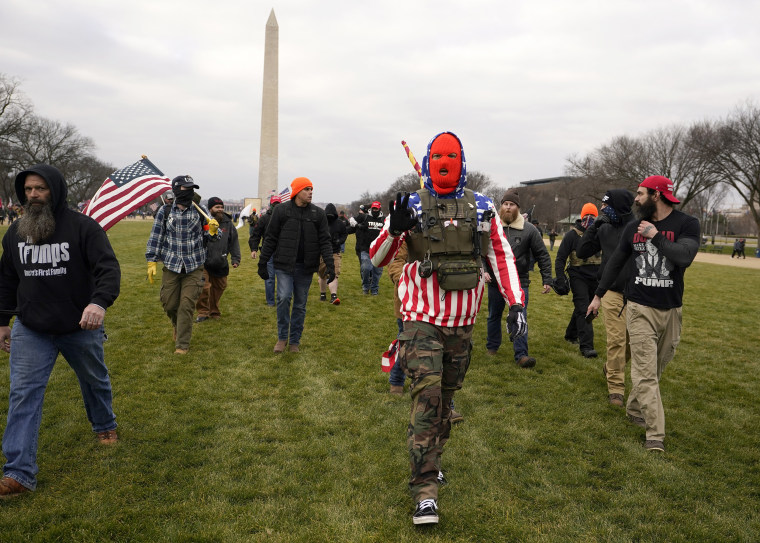
People march with those who say they are members of the Proud Boys as they attend a rally in Washington in support of Donald Trump on Jan. 6, 2021.Carolyn Kaster / AP file
By Ken Dilanian and Ben Collins
WASHINGTON — FBI officials have repeatedly said they gathered no credible intelligence in the weeks leading up to the Jan. 6 insurrection suggesting that pro-Trump extremists intended to storm the U.S. Capitol.
And even after months of intensive investigation, Justice Department prosecutors have presented no evidence so far that any of the 420 individuals charged to date for their actions on Jan. 6
planned in advance to attack the building in which Congress was certifying Joe Biden's victory in the presidential election.
But a new report by a nonprofit research group, and a separate review by NBC News, uncovered hundreds of social media posts discussing plans to move on the Capitol, including a map of the building and talk of how to create a stampede that would overwhelm Capitol Police.
"You know there will be riot police preventing us from getting in the capitol building," one anonymous poster wrote in December. "What if we created a stampede/crush situation? Start pushing from the back. Surely they will have to get out of the way or get crushed. They're not going to start shooting people."
One post on a very active forum for angry Trump fans called the TheDonald.win was titled "If we occupy the Capitol building, there will be no vote." The top response to that post reads: "GOTTA OVERWHELM THE BARRICADES AND COPS."
The posts raise new questions about whether the FBI missed or failed to act on these threats, and why federal prosecutors have so far said in court they have not determined whether anyone planned the attack in advance. A Justice Department spokesman and the FBI declined to comment.
"This information, sitting in plain sight on the internet
before Jan. 6, paints a clear picture of a planned and coordinated violent attack," Sen. Sheldon Whitehouse, a Rhode Island Democrat who serves on the Judiciary Committee, said in a statement to NBC News. "It's important to understand how much of this the FBI and DOJ knew, when they knew it, and how they decided which pieces of information warranted action."
In the past, FBI officials have said that unattributed comments on social media don't always add up to credible intelligence, in part because many people fail to act on the things they say online. They also have pointed to what they call an unvetted "situational information" report from their Norfolk field office describing unspecified plans to make "war" on the Capitol that was sent to law enforcement agencies around the country the night before the riots. That shows they did offer some warning, they say, while acknowledging the report did not circulate at the highest levels of the FBI.
Critics say the FBI missed a torrent of threats online in the days leading up to Jan. 6.
"There are thousands of posts — with tens of thousands of comments — detailing plans to travel to Washington and engage in violence against the U.S. Capitol," said Daniel Jones, a former FBI analyst and longtime Senate investigator who is now president of
Advance Democracy. "The ultimate end goal of this violence was, on behalf of Trump, to disrupt the Congress and overturn the presidential election."
The Advance Democracy report gathered the material from a now-defunct website, TheDonald.win, where Trump supporters vented their anger in the wake of an election they believed was stolen from the former president. The report was first detailed last week by the Washington Post. NBC News obtained the full cache of postings from the defunct website and reviewed material that was not included in the Advance Democracy report.
While some of those who posted on TheDonald.win participated in the Capitol riot — some posted photos of themselves on the scene that were reviewed by NBC News — what's not clear is whether any of those who posted specific plans or threats of violence against the Capitol are among the defendants who have been charged. The posts reviewed by NBC News are anonymous, and the court documents in the cases against alleged Capitol rioters don't always detail their social media handles.
Sen. Gary Peters, the Michigan Democrat who chairs the Homeland Security Committee, called what happened Jan. 6 "a massive and historic intelligence failure."

Trump supporters gather outside the Capitol building following a "Stop the Steal" rally on Jan. 6, 2021.Spencer Platt / Getty Images file
Still unclear is whether it was a failure to collect intelligence or a failure to act on intelligence that had been collected.
A report by the Capitol Police Inspector General released Thursday says that force's intelligence unit was aware that "Congress itself was the target on the 6th," but didn't act on it, leaving the Capitol poorly defended.
Yet the FBI, not the Capitol Police, is ultimately responsible for detecting and thwarting terrorism attacks, and FBI officials have continued to insist there was no intelligence failure. An investigation by the Department of Justice Inspector General is ongoing.
"None of us had any intelligence that suggested individuals were going to storm and breach the Capitol," Jill Sanborn, then the FBI's top counterterrorism official, told a Senate committee on March 3.
"We do not have at this point someone explicitly saying our plan is to force entry into the Capitol in order to stop the certification," an assistant U.S. attorney told a federal judge on March 12.
FBI officials have not said say whether anyone at the FBI was aware of the hundreds of posts calling for violence on TheDonald.win. The intelligence report from the FBI's Norfolk, Virginia, field office described threats to attack the Capitol, and was passed to the Capitol Police on Jan. 5. Sanborn called it "raw, unvetted information, and said neither she nor FBI Director Christopher Wray had been briefed on it.
Social media was teeming with angry rhetoric in the weeks before Jan. 6, and experts say it wasn't the usual venting.
On Jan. 5, NBC News published
a story based in part on postings from TheDonald.win, headlined "Violent threats ripple through far-right internet forums ahead of protest."
FBI officials acknowledge that there were calls for violence at the Jan. 6 "Stop the Steal" rally by Trump supporters, held just prior to the Capitol attack, but they say they did not add up to specific, credible intelligence.
Yet on TheDonald.win, the talk of attacking the Capitol was granular in its detail.
For example, many posters discussed surrounding the entire Capitol complex, including blocking tunnels that lead from surrounding House and Senate office buildings to the Capitol itself.
"Don't forget, there are three subways leading to and from the Capital that Congress uses to escape. Hypothetically speaking, if those were occupied or sabotaged, they'd have to come out and face us in order to leave," a user named "Free Speech Master" responded.

An anonymous post on TheDonald.win ahead of the Jan. 6 Capitol riot.obtained by NBC News
A map was posted showing entrances and exits to the Capitol and the tunnels that connect it to nearby House and Senate office buildings.
"Black X's are for those ready for action if Congress tries to certify the steal. There's 535 politicians and ~3500 guards," a poster under the username "The Mutualist" wrote on Dec. 28.
The map was reposted over the next several days. Some users expressed the belief that taking the Capitol would lead to a successful coup, because "all the other agencies… are directly under the control of Trump."

An anonymous post on TheDonald.win ahead of the Jan. 6 Capitol riot.obtained by NBC News
"Bring handcuffs and zipties to DC," reads another post from a user named CommunismSucks. "No more tolerating 'elected' officials who hate our country. January 6th is the chance to restore this country. Barging into the Capitol through multiple entryways is the surest way to have our bases covered and apprehend these traitors."
Some posts discussed what type of guns to bring, and how to build gallows and tie nooses to hang members of Congress.
A noose and makeshift gallows was in fact erected by rioters on the West side of the Capitol on Jan. 6.
One poster who said he "works on types of doors," discussed how rioters could break through the Capitol's historic doors.
"Remember, these are things that can be replaced…" the poster said. "So if you need to batter them down, go for it."
Some users on TheDonald.win asked for help in joining extremist groups, including The Proud Boys, some of whose members have been charged with conspiracy in the Capitol riots.
After a Dec. 19 post on TheDonald.win titled "How do I join the Proud Boys?" the most popular response was by the user eplettner: "Come to DC on January 6th."
"That's the plan," the original poster responded.

An anonymous post on TheDonald.win ahead of the Jan. 6 Capitol riot.obtained by NBC News
Users posted pictures of flights and buses full of Trump supporters en route to D.C. for the event on the 6. One user, who called themself "2021is1776," posted a picture of his hotel room full of weapons and tactical gear.
"Hoping not to need them they are a contingency, plenty of other items on hand for anything other than all out...well you know. the escalation is up to the BLM/ Police," that user wrote.

An anonymous post on TheDonald.win ahead of the Jan. 6 Capitol riot.obtained by NBC News
Hours before the riots, users began posting lists of government officials they hoped to "track down." "When all of the s--t starts, I want to be in the group that tracks down this guy," the user BlooperBoy wrote above a picture of Anthony Fauci on Jan. 5.
An anonymous post on TheDonald.win ahead of the Jan. 6 Capitol riot.obtained by NBC News
"Congress has a choice to make tomorrow," reads a post by the user Doejohnblowjoe, followed by a meme that reads "Certify Trump" or "Get Lynched by Patriots."
An anonymous post on TheDonald.win ahead of the Jan. 6 Capitol riot.obtained by NBC News
It wasn't just on TheDonald.Win. Other posters on 4chan's /pol/ board, which is unaffiliated with TheDonald but shares extremist far-right users and viewpoints, made even more explicit threats before Jan. 6.
"You can go to Washington on Jan 6 and help storm the Capitol," one anonymous user wrote on Jan. 5. "As many patriots as can be. We will storm the government buildings, kill cops, kill security guards, kill federal employees and agents, and demand a recount."
As NBC News has previously reported, confusion and caution pervades the FBI's approach to reviewing social media. Even though the Justice Department guidelines that govern FBI tactics say the bureau should be proactive in hunting for threats, the FBI says
it must wait for a tip before it can look even at public social media.
Rep. Adam Schiff, D-Calif., the chairman of the House Intelligence Committee, asked FBI Director Christopher Wray about the issue at last week's hearing on top national security threats.
"It appears that probably some of the best intelligence prior to Jan. 6 was open source," Schiff said. "It was discussion on social media (about) plans to attack the Capitol. This raises a important but very difficult question for the bureau….what is the bureau's policy in terms of your ability to review social media when it's appropriate to do it when it's not appropriate to do it? Do you have a clear policy on that, and are there legal constraints as well that preclude you from getting the intelligence that you need?"
In his response, Wray said that absent a tip or some other impetus, the bureau was not free to hunt for threats of violence or domestic terror plots social media, even if the posts are public.
"We do not as the FBI, simply patrol social media, looking for problems," he said.
He added, "We have properly predicated investigations where we look at social media as a key part of those investigations. We get tips from social media companies, which we follow up on. We get tips from members of the public about things they see on social media. And if we have the appropriate predication, we follow up on those."
He did not address the Justice Department guidelines that govern the FBI, which state:
"To carry out its central mission of preventing the commission of terrorist acts against the United States and its people, the FBI must proactively draw on available sources of information to identify terrorist threats and activities…It cannot be content to wait for leads to come in through the actions of others, but rather must be vigilant in detecting terrorist activities to the full extent permitted by law, with an eye towards early intervention and prevention of acts of terrorism before they occur."


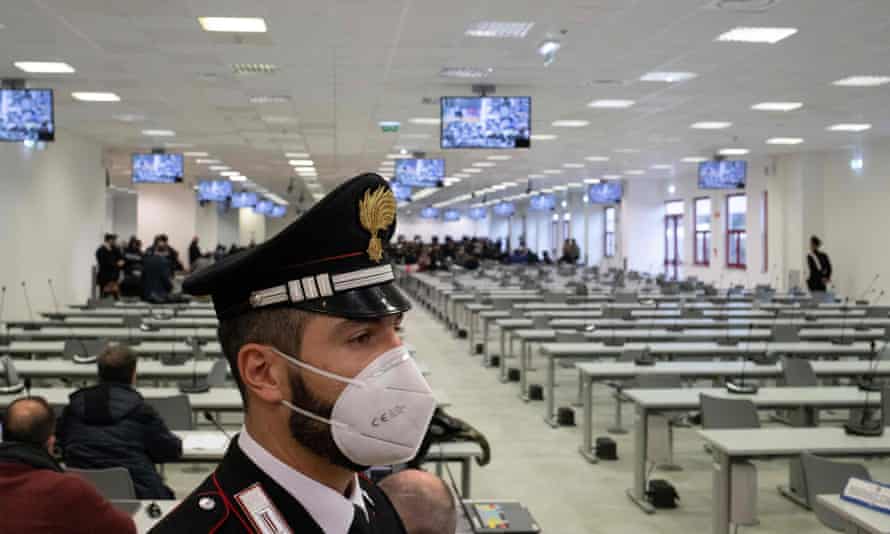 A Carabinieri police officer stands guard at the start of the trial of more than 350 alleged members of Calabria’s ‘Ndrangheta mafia group and associates. Photograph: Gianluca Chininea/AFP/Getty Images
A Carabinieri police officer stands guard at the start of the trial of more than 350 alleged members of Calabria’s ‘Ndrangheta mafia group and associates. Photograph: Gianluca Chininea/AFP/Getty Images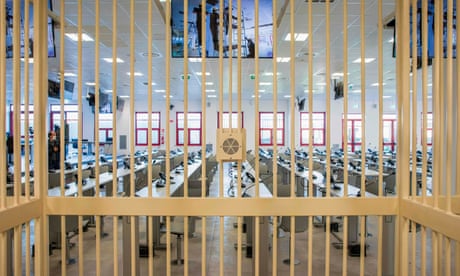
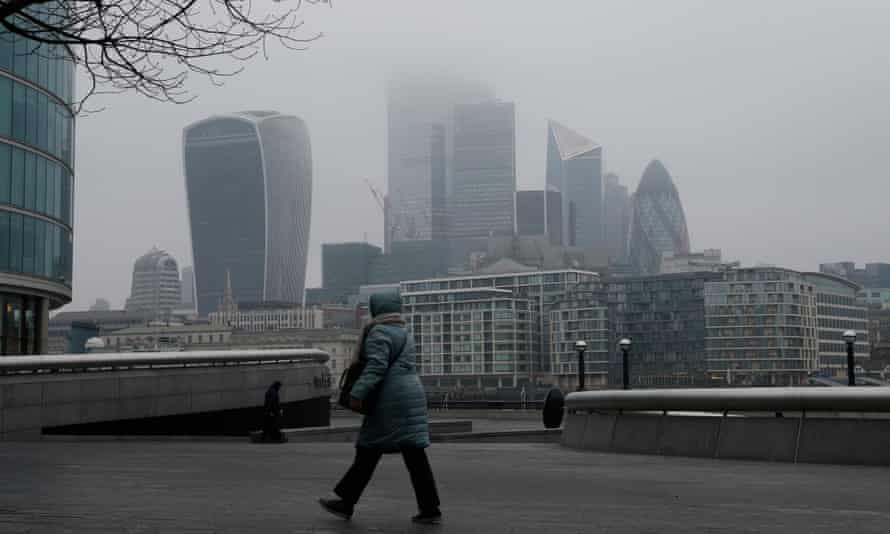 A woman walks past a view of the City of London skyline at sunrise in March. Photograph: Hollie Adams/Getty Images
A woman walks past a view of the City of London skyline at sunrise in March. Photograph: Hollie Adams/Getty Images
 © Sean Rayford/Getty Images
© Sean Rayford/Getty Images © Sean Rayford/Getty Images Demonstrators hold signs during a protest march, April 24, 2021, in Elizabeth City, N.C., calling for the release of body camera footage from the shooting death of Andrew Brown Jr., 3 days prior.
© Sean Rayford/Getty Images Demonstrators hold signs during a protest march, April 24, 2021, in Elizabeth City, N.C., calling for the release of body camera footage from the shooting death of Andrew Brown Jr., 3 days prior.
 © Jim Lo Scalzo/EPA via Shutterstock Andrew Brown's youngest daughter listens to Attorney Benjamin Crump, who is representing the Brown family, speak outside the Pasquotank County Sheriff's Office in Elizabeth City, N.C., April 26, 2021.
© Jim Lo Scalzo/EPA via Shutterstock Andrew Brown's youngest daughter listens to Attorney Benjamin Crump, who is representing the Brown family, speak outside the Pasquotank County Sheriff's Office in Elizabeth City, N.C., April 26, 2021.













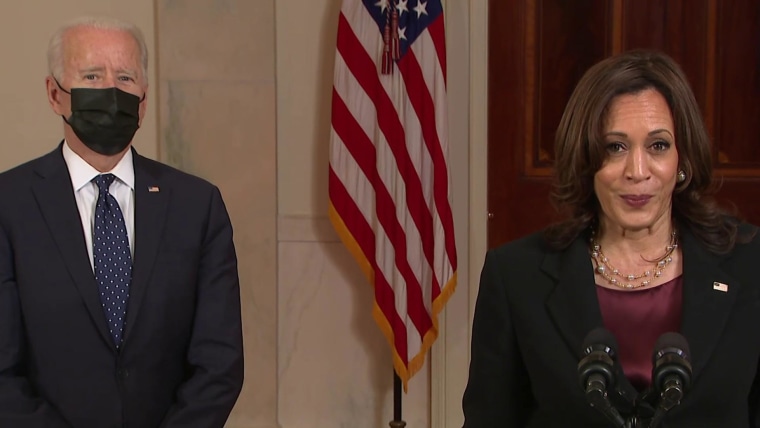
 People march with those who say they are members of the Proud Boys as they attend a rally in Washington in support of Donald Trump on Jan. 6, 2021.Carolyn Kaster / AP file
People march with those who say they are members of the Proud Boys as they attend a rally in Washington in support of Donald Trump on Jan. 6, 2021.Carolyn Kaster / AP file Trump supporters gather outside the Capitol building following a "Stop the Steal" rally on Jan. 6, 2021.Spencer Platt / Getty Images file
Trump supporters gather outside the Capitol building following a "Stop the Steal" rally on Jan. 6, 2021.Spencer Platt / Getty Images file An anonymous post on TheDonald.win ahead of the Jan. 6 Capitol riot.obtained by NBC News
An anonymous post on TheDonald.win ahead of the Jan. 6 Capitol riot.obtained by NBC News An anonymous post on TheDonald.win ahead of the Jan. 6 Capitol riot.obtained by NBC News
An anonymous post on TheDonald.win ahead of the Jan. 6 Capitol riot.obtained by NBC News An anonymous post on TheDonald.win ahead of the Jan. 6 Capitol riot.obtained by NBC News
An anonymous post on TheDonald.win ahead of the Jan. 6 Capitol riot.obtained by NBC News An anonymous post on TheDonald.win ahead of the Jan. 6 Capitol riot.obtained by NBC News
An anonymous post on TheDonald.win ahead of the Jan. 6 Capitol riot.obtained by NBC News